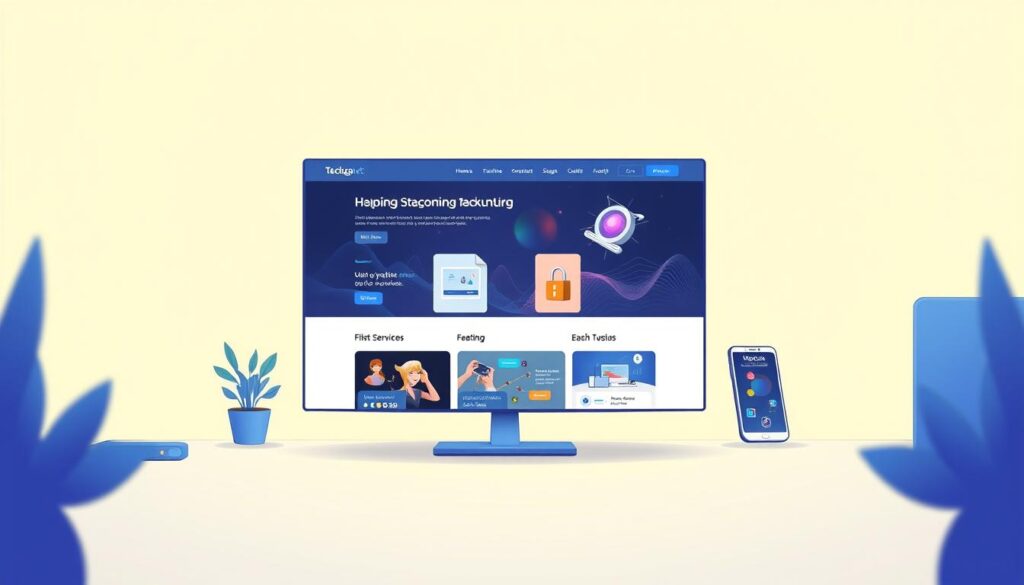In today’s digital-first world, the connection between a seamless interface and higher conversion rates is undeniable. Businesses that prioritize intuitive design and strategic improvements often see significant growth in customer engagement and loyalty. By focusing on creating a smooth journey for visitors, companies can transform casual browsers into committed buyers.
Data shows that well-optimized design elements can lead to lower bounce rates and higher engagement. For example, industry leaders like Amazon and Netflix have mastered the art of combining speed, simplicity, and relevance to keep users coming back. These examples highlight the importance of aligning design with customer expectations.
Looking ahead, ecommerce trends for 2025 emphasize the need for mobile-friendly layouts and personalized interactions. Staying ahead of these trends ensures businesses remain competitive in an ever-evolving market. By leveraging data-driven decisions and emerging technologies, companies can create experiences that not only attract but also retain customers.
Key Takeaways
- Intuitive design enhances engagement and loyalty.
- Strategic improvements can lower bounce rates.
- Mobile-friendly layouts are essential for future growth.
- Personalized interactions drive higher conversion rates.
- Data-driven decisions ensure long-term success.
Understanding Ecommerce Development in 2025
The ecommerce landscape is evolving rapidly, with 2025 set to bring transformative changes. Businesses must stay ahead by embracing emerging trends and innovative technologies. This shift will redefine how we shop online, making it essential to adapt to new consumer expectations.
Emerging Trends and Future Growth
By 2025, ecommerce will be shaped by trends like mobile-first strategies and personalized shopping. Mobile traffic is expected to dominate, making responsive design a priority. Additionally, consumers will demand eco-friendly products, pushing businesses to adopt sustainable practices.
Innovative Technologies Shaping Digital Commerce
Technologies like AI and AR are revolutionizing ecommerce. AI-powered tools will enhance personalization, improving customer satisfaction and boosting conversion rates. Augmented reality will allow shoppers to visualize products, reducing return rates and enhancing the overall shopping experience.
The Impact of User Experience on Conversion Rates
The way a site is structured directly influences its success. A well-designed website can turn casual visitors into loyal customers. By focusing on intuitive layouts and clear content, businesses can guide users toward meaningful actions.
Streamlining the journey from landing on a page to completing a purchase is crucial. For example, simplifying navigation and reducing form fields can lower cart abandonment rates. Industry leaders like Amazon have mastered this approach, ensuring every step feels effortless.
Clear content and intuitive design play a significant role in keeping visitors engaged. When users find what they need quickly, they’re more likely to take action. Effective design choices ensure that every interaction feels seamless and purposeful.
Practical examples show how small changes can lead to big results. For instance, adding videos to product pages can increase engagement by 86%. Similarly, optimizing for mobile ensures that users have a consistent experience across devices.
Ultimately, a positive experience keeps visitors on the site longer and guides them toward conversion. By focusing on the details, businesses can create a journey that feels natural and rewarding for every user.
Best Practices in User Experience Optimization for Conversions
Creating a website that guides visitors effortlessly is key to driving meaningful actions. By focusing on strategic design and usability, businesses can ensure that every interaction feels intuitive and purposeful.

Strategic Design Elements and Usability
Understanding customer needs is essential for crafting a seamless journey. Start by simplifying navigation and reducing friction points. For example, clear calls to action drive results by guiding visitors toward desired outcomes.
Usability testing plays a crucial role in identifying pain points. By gathering feedback, businesses can make iterative improvements that enhance satisfaction. A study found that simplifying forms can increase submissions by up to 50%.
Data-Driven Decision Making
Data-backed improvements ensure that every change aligns with customer expectations. Tools like heatmaps and A/B testing reveal insights into user behavior. For instance, optimizing for mobile can lead to a 67% increase in conversions.
Real-world examples show the power of analytics. Companies that prioritize data-driven strategies often see measurable growth. As highlighted in this guide, continuous monitoring leads to long-term success.
Data Insights: Using Analytics for UX Enhancement
Harnessing data insights is essential for refining design and improving engagement. By leveraging tools like Google Optimize and session recordings, we can uncover actionable insights to enhance website performance. This approach ensures that every change is backed by real-time data, leading to meaningful improvements.

A/B Testing and Iterative Design
A/B testing allows us to compare different design elements and identify what works best. For example, testing headlines or button colors can reveal preferences that boost engagement. Iterative design, fueled by continuous testing, ensures that our website evolves to meet customer needs.
Real-time data helps refine design elements, making them more effective over time. This process not only improves usability but also drives higher conversion rates. By focusing on small, data-backed changes, we create a seamless journey for visitors.
Customer Behavior Analysis
Understanding how customers interact with our site is key to pinpointing friction points. Tools like heatmaps and session recordings provide visual insights into user behavior. For instance, if users frequently abandon a form, we can simplify it to reduce frustration.
Quantitative datum guides effective changes, ensuring that every adjustment aligns with customer expectations. By analyzing engagement metrics like bounce rates and session durations, we can make informed decisions that enhance the overall experience.
- Data insights refine design elements through rigorous A/B testing.
- Customer behavior analysis identifies friction points in navigation.
- Iterative design ensures continuous improvement based on real-time data.
- Quantitative analytics guide engaging and conversion-friendly experiences.
- Improvements in engagement translate into measurable growth.
Collaboration Between Design, Development, and Marketing
Effective collaboration between teams is the backbone of a seamless digital journey. When design, development, and marketing work together, they create a unified strategy that enhances both functionality and engagement. This synergy ensures that every change aligns with broader goals, delivering a cohesive experience for visitors.

Cross-Functional Team Strategies
Cross-functional collaboration is essential for implementing successful strategies. By combining expertise from different departments, we can identify pain points and craft solutions that improve usability. For example, simplifying a form based on feedback from all teams can lead to higher completion rates.
Regular testing and feedback loops ensure continuous improvement. When design changes are validated through data and aligned with marketing goals, they drive measurable results. This approach not only enhances the interface but also supports overarching business objectives.
Aligning Campaign Messaging for Cohesive UX
Aligning design changes with campaign messaging creates a consistent and engaging experience. When visuals and content reflect the same message, visitors are more likely to take desired actions. For instance, a campaign promoting ease of use should be mirrored in the site’s navigation and form design.
Integrating marketing insights with technical implementations ensures that every element serves a purpose. This alignment not only improves usability but also boosts engagement and conversion metrics. By working together, teams can create a digital presence that feels seamless and purposeful.
Optimizing for Mobile: Enhancing the User Journey
Mobile devices dominate online interactions, making responsive design a critical factor for success. With over 50% of global traffic coming from smaller screens, businesses must prioritize mobile-friendly layouts to keep visitors engaged and drive meaningful actions.

Responsive Design Techniques
Responsive design ensures that a site adapts seamlessly to any screen size. This approach improves performance by reducing load times and enhancing usability. For example, companies like Amazon use fluid grids and flexible images to create a consistent experience across devices.
Key strategies include:
- Using media queries to adjust layouts dynamically.
- Optimizing images and videos for faster loading.
- Implementing touch-friendly elements for easier navigation.
These techniques not only boost engagement but also addvalueby making the site accessible to a broader audience.
Reducing Mobile Friction
Simplifying navigation is essential for reducing friction on mobile devices. Studies show that 90% of users abandon apps due to poor performance, such as slow loading times or crashes. By streamlining menus and minimizing form fields, businesses can create a smoother journey.
Additional strategies include:
- Prioritizing content clarity to guide users effectively.
- Testing regularly to identify and fix pain points.
- Ensuring buttons and links are easy to tap on smaller screens.
These efforts directlyimpact conversionrates by keeping visitors engaged and reducing frustration.
Case studies reveal that companies investing in mobile optimization see measurable growth. For instance, Inspire Fitness experienced a 460% increase in user activity after implementing data-driven strategies. This highlights the value of continuous testing and improvement.
In a mobile-first world, optimizing for smaller screens is no longer optional—it’s a necessity. By focusing on responsive design and reducing friction, businesses can create experiences that drive engagement and deliver long-term success.
Streamlining Navigation and Content for Engagement
Streamlined navigation and clear content are the backbone of a successful website. When these elements work together, they create a seamless journey that keeps visitors engaged and encourages them to take action. By focusing on intuitive design and organized information, we can guide users toward meaningful interactions.

Intuitive Menu Layouts
Intuitive menus make it easy for visitors to find what they’re looking for. A well-structured navigation system reduces effort and frustration, leading to lower bounce rates. For example, using clear labels and logical hierarchies ensures users can explore your site without confusion.
Mobile-friendly designs are also crucial. With over 50% of traffic coming from smaller screens, responsive menus ensure accessibility across devices. This approach not only improves usability but also supports deeper site exploration.
Effective Calls to Action and Content Clarity
Clear calls to action (CTAs) prompt immediate responses. Whether it’s a button or a link, a well-designed CTA stands out and guides users toward the next step. Pairing these with concise, organized content ensures visitors understand your message quickly.
Balancing aesthetics with functional clarity is key. For instance, using contrasting colors for CTAs and breaking text into digestible sections enhances readability. This combination keeps users engaged and increases the likelihood of conversions.
Here are some tips for creating effective layouts:
- Simplify navigation menus to reduce friction.
- Use clear, action-oriented language in CTAs.
- Organize content into short paragraphs and bullet points.
- Test layouts regularly to identify and fix pain points.
By continuously refining these elements based on feedback and data, we can create a browsing experience that feels natural and rewarding. This approach not only boosts engagement but also drives measurable results.
Leveraging Customer Feedback and Usability Testing
Understanding customer behavior is the foundation of creating a website that truly meets their needs. By gathering direct feedback and conducting structured tests, we can uncover insights that drive meaningful improvements. This process ensures that every change aligns with what visitors want and expect.
Continuous usability testing reveals pain points and barriers that might otherwise go unnoticed. For example, identifying why visitors abandon a form or struggle with navigation helps us address these issues effectively. These insights guide iterative changes, ensuring the site evolves to meet evolving needs.
Implementing Continuous Improvement
Collecting feedback efficiently is key to this process. Tools like on-site surveys and heatmaps provide real-time data on how visitors interact with the site. This information helps us prioritize changes that have the most significant impact on service quality and satisfaction.
Iterative improvements based on testing have resolved common issues, such as confusing layouts or slow load times. For instance, simplifying checkout processes has led to a measurable increase in completed transactions. This cycle of assessment, redesign, and retesting ensures the site remains aligned with customer goals.
Commitment to continuous improvement is vital for sustaining high performance. By regularly analyzing feedback and testing new solutions, we create a site that not only attracts visitors but also keeps them engaged. This approach ensures long-term success and a seamless journey for every visitor.
Anticipating Future Ecommerce Technologies and Trends
The future of ecommerce is being shaped by groundbreaking technologies that redefine how we shop online. As businesses prepare for 2025 and beyond, staying ahead of these trends is essential to remain competitive and meet evolving customer expectations.
Integration of AI and Personalization
Artificial intelligence is revolutionizing the way businesses interact with customers. By analyzing behavior and preferences, AI delivers personalized experiences that drive engagement. For example, chatbots and virtual assistants provide real-time support, enhancing the shopping journey.
Predictive analytics also plays a key role. It allows brands to anticipate needs and offer tailored recommendations. This not only improves satisfaction but also builds trust by making every interaction feel meaningful.
Adopting Emerging Digital Platforms
New platforms are changing how we approach ecommerce. Social commerce, for instance, integrates shopping features into apps like Instagram and TikTok. This creates seamless opportunities for brands to connect with customers where they already spend time.
Voice and visual search are also gaining traction. These tools make it easier for shoppers to find products quickly, reducing friction and improving the overall experience. By embracing these innovations, businesses can stay relevant in a fast-paced market.
However, adopting new technologies comes with challenges. Issues like data privacy and system integration require careful planning. Addressing these concerns ensures a smooth transition and maintains customer trust.
- AI-driven personalization enhances customer satisfaction and loyalty.
- Emerging platforms like social commerce expand reach and engagement.
- Voice and visual search simplify the shopping process for users.
- Addressing potential issues early builds trust and ensures success.
- Staying ahead of trends positions businesses for long-term growth.
By leveraging these technologies, we can create a future where ecommerce is more intuitive, efficient, and customer-focused. The key is to embrace innovation while addressing challenges head-on.
Real-World Success Stories in UX and Conversion Optimization
Industry leaders like Google and Netflix have proven that strategic design choices can transform browsing into buying. By focusing on their audience’s needs and leveraging analytics, these companies have achieved remarkable results. Their success stories offer valuable lessons for businesses aiming to improve their own strategies.
Case Studies of Industry Leaders
Google’s approach to analytics has set a benchmark for others. By using data to refine their search interface, they’ve created a seamless way for users to find information quickly. This focus on usability has led to higher engagement and retention rates.
Netflix, on the other hand, excels in personalization. Their recommendation engine analyzes viewing habits to suggest content tailored to each audience member. This strategy has significantly boosted their conversion rates and customer loyalty.
Apple’s minimalist design philosophy is another standout example. By simplifying navigation and prioritizing clarity, they’ve made it easy for users to explore their products. This approach has resulted in increased sales and a stronger brand connection.
Airbnb’s success lies in their collaborative strategy. By integrating feedback from both hosts and guests, they’ve created a platform that meets the needs of all users. Their iterative design process ensures continuous improvement and satisfaction.
Key Takeaways and Lessons Learned
These case studies highlight the importance of a well-planned strategy. Here are some key lessons:
- Use analytics to understand your audience and refine your approach.
- Simplify navigation to create a seamless way for users to interact with your site.
- Personalize experiences to meet the specific needs of your visitors.
- Collaborate across teams to ensure every design choice aligns with your goals.
- Iterate based on feedback to continuously improve performance.
By adopting these practices, businesses can create experiences that not only attract but also retain their audience. The success of these industry leaders shows that a thoughtful strategy is the key to driving meaningful results.
Conclusion
To achieve lasting success in ecommerce, aligning design with customer needs is crucial. By focusing on feedback and iterative testing, we can create seamless journeys that drive meaningful actions. This approach not only helps increase conversion rates but also builds trust and loyalty.
Future trends like mobile-first strategies and AI-driven personalization will continue to shape the industry. Staying ahead requires continuous improvement and a commitment to understanding what works best for your audience. These efforts ensure long-term growth and sustained success.
By adopting these best practices, businesses can enhance satisfaction and drive sales effectively. Let’s embrace innovation and refine our strategies to create experiences that truly resonate.



